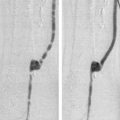Pain control – forward planning
Many interventional radiology procedures do not require any analgesia; some procedures are intrinsically painful, especially if they are prolonged, and others are unpredictably uncomfortable. The procedure will be simpler and the patient less distressed if pain can be kept to a minimum; they will be even happier if pain can be avoided altogether. Preventing severe pain is likely to increase everyone’s confidence in you! Remember pain and anxiety affect the patient pre-, peri- and post-procedure to a varying degree, so there is no ‘one size fits all’ solution. As always, forward planning is the key to success; recognize which procedures and which particular stages are likely to require analgesia.
If a procedure is predicted to be painful,
e.g. uterine artery embolization:
- •
Explain this to the patient in advance and reassure them that this is normal and that effective pain control will be provided.
- •
Prophylactic analgesia should be given to minimize/prevent it. Combinations of non-steroidal and opiate analgesics are often used.
- •
Prescribe appropriate medication before starting (e.g. analgesic, antiemetic, sedative).
- •
Have someone check regularly whether the pain control is effective. Give additional analgesia and pain control as necessary. Patient-controlled analgesia (PCA) is useful here.
- •
Suitable analgesia should be prescribed for the post-procedural period.
If you anticipate giving intravenous drugs on several occasions during a procedure, attach a low-pressure connector to the venous access and locate it in an easily accessible position. This means you will not have to interrupt the procedure while someone rummages around under the drapes trying to find a cannula each time a drug is given. Remember that a saline flush is needed or the drug will just sit in the tubing!
If a patient experiences unexpected pain during or after a procedure
- •
Establish what is causing the pain and what can be done to resolve it, e.g. stress-related angina may respond to the usual glyceryl trinitrate spray.
- •
Treat pain swiftly and effectively. This is not the time for oral paracetamol (acetaminophen); intravenous opiate analgesics are the order of the day, so remember to ensure that venous access is obtained in advance.
If a procedure is likely to have painful consequences
- •
Plan for this in advance by prescribing a suitable analgesic regimen. This is particularly important following embolization.
- •
Review the patient to ensure that clinical evolution is satisfactory.
You should become familiar with the regimens and preparations in use at your institution. Remember that the actions of sedatives and analgesics are often synergistic (antidotes to reverse the effects of both are available). Anaesthetists are expert at managing pain and should be consulted if there is any doubt regarding appropriate medication or the need for adjunctive procedures such as epidural or spinal anaesthesia.
Some typical regimens
Pre-procedure medication for painful procedures, especially those likely to induce inflammation, e.g. embolization of solid organs.
Non-steroidal anti-inflammatory drugs (NSAIDs),
e.g.:
- •
Intravenous (IV) paracetamol 1 g
- •
Per rectum (PR) diclofenac 25–50 mg.
Opiate analgesics,
e.g.:
- •
Morphine 1–5 mg is estimated according to patient size (e.g. little old lady, 1 mg).
- •
Fentanyl (Sublimaze) usually given in 20–40 µg aliquots. Fentanyl has faster onset and shorter duration of action and is almost 100× more potent than morphine.
- •
Caution: Start with a low dose and increase as necessary. Elderly patients are often very sensitive to the sedating properties of these drugs. Opiates and sedatives have a synergistic effect.
- •
Consider concomitant antiemetic therapy. Cyclizine (50 mg), ondansetron (4 mg), metoclopramide (10 mg), are all effective.
- •
Monitor. Pulse, BP and oxygen saturation.
- •
Reversal. Naloxone 100–200 mg (1.5–3 mg/kg) by IV injection. If the response is inadequate, give increments of 100 mg every 2 min. Repeat as necessary.
Stay updated, free articles. Join our Telegram channel

Full access? Get Clinical Tree



